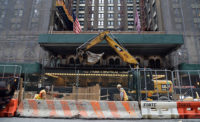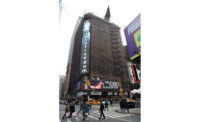About 90% of construction sites are not currently active, said New York City Dept. of Buildings Commissioner Melanie LaRocca in an April 23 live-streamed Q&A, adding detail on the process to get projects certified as "essential" during the state's COVID-19-sparked shutdown. She also discussed why her inspectors repeatedly visit closed sites and how agency changes may help the industry get back up to speed after all work resumes, which now is set for May 15 but not assured.
[For ENR’s latest coverage of the impacts of the COVID-19 pandemic, click here]
According to New York state Gov. Andrew Cuomo's expanded executive order in late March, essential projects allowed to proceed include roads, bridges, transit facilities, utilities, hospitals and health care facilities, affordable housing, homeless shelters, schools and emergency repairs. Projects allowed to continue work are defined by the Empire State Development Corp. In New York City, projects also must also be certified by the DOB.
“If you believe you are essential and you want to reactivate your site” or if a project team needs to make emergency reports, La Rocca said, firms should go through the department’s online portal and “get your certificate from us, which you can put on your job site, so it’s clear to everybody that you’ve been deemed essential.” There’s also an appeal process if a project is denied certification.
More than 5,000 Projects Approved
A DOB spokesman confirmed on April 24 that 5,091 construction jobsites in the city were approved to continue for essential work, emergency work or work done by a single worker on a site.
On March 30, in response to the governor's order to shut non-essential projects, the department ordered more than 35,000 sites to close, a
DOB spokesman told ENR. He explained that sites that have been allowed to proceed since then include those initially deemed essential, like hospitals and affordable housing projects; previously closed non-essential sites that were approved after submitting essential construction requests; sites approved for solitary work; and sites approved for emergency work in the interest of public safety.
During the Q&A, sponsored by the New York Building Congress, La Rocca also explained why DOB inspectors continue to visit sites whether they are certified or closed.
“Just because you’re essential does not mean the department is never coming by again," she said. "We have to make sure you’re doing it correctly, and if you’re essential because of an emergency, we have to make sure you’re doing it to the scope" of the emergency.
Projects where work has stopped will still be inspected, the commissioner said, because “we are making sure nonessential sites are not activated and that sites remain safe for the public.”
LaRocca confirmed that some hotel projects have been deemed essential and have resumed work around the city, but she explained that they must meet certain criteria, such as being alterations of existing buildings, and having permits that were issued before April 15.
Staffing Accordingly
La Rocca made no definitive comment in response to a query from Building Congress CEO Carlo Scissura about the possibility of after-hours work, particularly to help the industry catch up after shutdowns end, but she addressed how the DOB would deal with being “bombarded” by inspection requirements and permit requests.
“We’ve started to look at the entire universe. We can expect what the volume is going to be and staff accordingly,” she said. “I don’t expect tremendous delays—it might take a handful of days and not two to three weeks to get that last piece of paper.
La Rocca also noted that new technologies implemented in the DOB during the pandemic will remain to assist in more efficient operation. The department is using e-filing, phone calls and email to reduce in-person interactions, a move that began before the pandemic.
If the May 15 shutdown end-date holds or is extended, LaRocca said it is unclear how the state will allow work on non-essential projects to resume. “Whether the governor is going to say, ‘everybody—tomorrow, go back to work,’ or phase in the approach, your best guess is my best guess,” she said.






Post a comment to this article
Report Abusive Comment